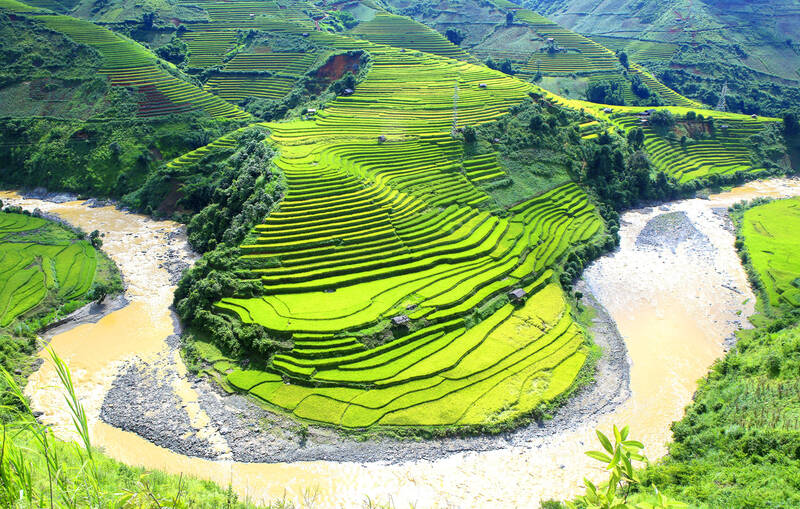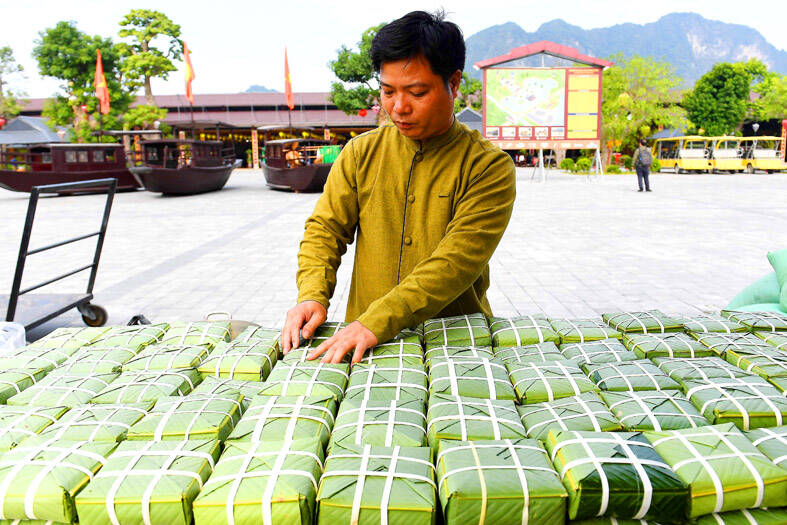When he was a child, Dong Van Canh watched while the rice fields of Vietnam’s Mekong Delta were set alight to make way for the next crop, blackening the sky and flooding the air with potent greenhouse gases.
Rice — Asia’s principal staple — is to blame for about 10 percent of global emissions of methane, a gas that for more than two decades traps about 80 times as much heat as carbon dioxide. Usually associated with cows burping, high levels of methane are also generated by bacteria that grow in flooded rice paddies and thrive if leftover straw rots in the fields after harvest.
The message from scientists is: Rice cannot be ignored in the battle to cut emissions.

Photo: AP
In the Mekong Delta, Canh, a 39-year-old rice farmer, does not leave straw out to decay on the paddies — nor does he burn it, as his parents did before him. Motivated by the memory of being forced inside his home on days the smoke was thick — sometimes so acrid it made him choke or faint — he joined an initiative that removes straw from the fields and turns it into mushrooms and organic fertilizer, earning a small income on the side.
“If we can collect the straw and make money, all of us benefit,” he said, running his fingers through a large, soft mound of straw, cow dung and rice husks that were to become nutritious food for Mekong crops.
The program — organized by the International Rice Research Institute (IRRI) — is one of a handful across Vietnam and the region trying to steadily shrink methane emissions from rice production.

Photo: AFP
Many of the initiatives are not new, but have been spotlighted since about 100 countries signed the Global Methane Pledge two years ago, agreeing to reduce emissions by 30 percent from 2020 levels by 2030. Several of the world’s biggest rice producers, including Indonesia, Bangladesh and Vietnam, are on board — although the two largest, China and India, did not sign.
In Vietnam, as the harvesting season draws to a close, farmers push carts overflowing with straw bales that would later be soaked and laid out to grow straw mushrooms.
Once the fungi are ready, they would be sold before the farmers take back the straw and funnel it into a composting machine. Two months later it would be ready — and can be sold for about US$0.15 per kilogram.
“In the past a few farmers did this manually, but it took too much manpower and the cost was high. Now we’ve cut costs by half and we will expand to meet the demands of the market,” said Le Dinh Du, a rice farmer who heads the local district’s plant protection department. “The rice goes on a nice journey. We don’t waste anything.”
The Vietnamese Ministry of Natural Resources and Environment said that irrigated rice accounted for almost half of the country’s methane emissions in 2019.
Climate-friendly straw management has been introduced and spread “widely to farmers and local agricultural officials” throughout the country, according to CGIAR, an international agricultural research center.
How many practice what they have learned is unclear.
Last year, the World Bank said that more than 80 percent of rice straw in the Mekong Delta is still burned in the fields after harvest.
The need to find solutions is pressing. Unlike other crops, rice paddies have a layer of standing water, so there is no exchange of air between the soil and the atmosphere, said Bjoern Ole Sander, a senior scientist at the IRRI in Hanoi.
These conditions mean different bacteria are active in rice, compared with wheat or maize fields, he said.
“These bacteria eat organic matter and produce methane,” he said.
As well as straw management, IRRI said that another scheme, called alternate wetting and drying, which involves breaking up standing water to replenish oxygen and reduce methane-producing bacteria, could also help cut emissions.
Practiced on more than 200,000 hectares of rice-growing land in the Mekong delta’s An Giang area, it has made a significant difference, CGIAR said.
For Mekong farmers who have taken the leap, there is pride in contributing to more sustainable farming while getting the most out of their crops.
“We lived hard lives,” said Canh. “But once we realized how to take advantage of the straw, things have gotten easier.”

Intel Corp chief executive officer Lip-Bu Tan (陳立武) is expected to meet with Taiwanese suppliers next month in conjunction with the opening of the Computex Taipei trade show, supply chain sources said on Monday. The visit, the first for Tan to Taiwan since assuming his new post last month, would be aimed at enhancing Intel’s ties with suppliers in Taiwan as he attempts to help turn around the struggling US chipmaker, the sources said. Tan is to hold a banquet to celebrate Intel’s 40-year presence in Taiwan before Computex opens on May 20 and invite dozens of Taiwanese suppliers to exchange views

Application-specific integrated circuit designer Faraday Technology Corp (智原) yesterday said that although revenue this quarter would decline 30 percent from last quarter, it retained its full-year forecast of revenue growth of 100 percent. The company attributed the quarterly drop to a slowdown in customers’ production of chips using Faraday’s advanced packaging technology. The company is still confident about its revenue growth this year, given its strong “design-win” — or the projects it won to help customers design their chips, Faraday president Steve Wang (王國雍) told an online earnings conference. “The design-win this year is better than we expected. We believe we will win

Chizuko Kimura has become the first female sushi chef in the world to win a Michelin star, fulfilling a promise she made to her dying husband to continue his legacy. The 54-year-old Japanese chef regained the Michelin star her late husband, Shunei Kimura, won three years ago for their Sushi Shunei restaurant in Paris. For Shunei Kimura, the star was a dream come true. However, the joy was short-lived. He died from cancer just three months later in June 2022. He was 65. The following year, the restaurant in the heart of Montmartre lost its star rating. Chizuko Kimura insisted that the new star is still down

While China’s leaders use their economic and political might to fight US President Donald Trump’s trade war “to the end,” its army of social media soldiers are embarking on a more humorous campaign online. Trump’s tariff blitz has seen Washington and Beijing impose eye-watering duties on imports from the other, fanning a standoff between the economic superpowers that has sparked global recession fears and sent markets into a tailspin. Trump says his policy is a response to years of being “ripped off” by other countries and aims to bring manufacturing to the US, forcing companies to employ US workers. However, China’s online warriors